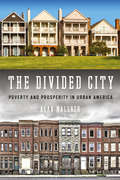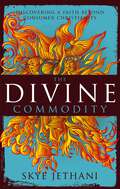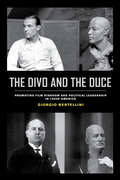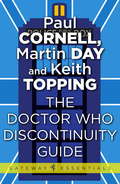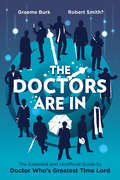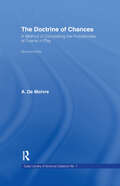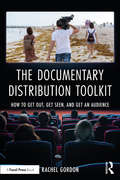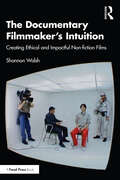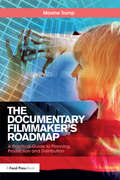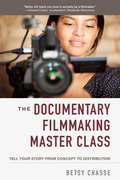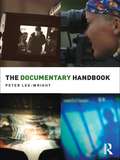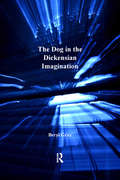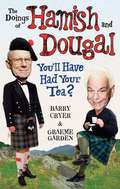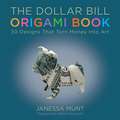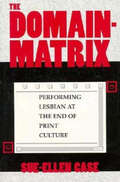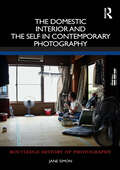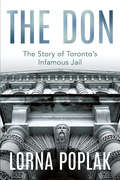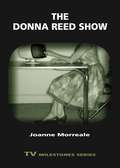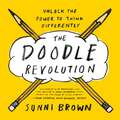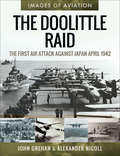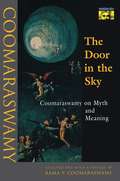- Table View
- List View
The Divided City: Poverty and Prosperity in Urban America
by Alan MallachIn The Divided City, urban practitioner and scholar Alan Mallach presents a detailed picture of what has happened over the past 15 to 20 years in industrial cities like Pittsburgh and Baltimore, as they have undergone unprecedented, unexpected revival. He spotlights these changes while placing them in their larger economic, social and political context. Most importantly, he explores the pervasive significance of race in American cities, and looks closely atthe successes and failures of city governments, nonprofit entities, and citizens as they have tried to address the challenges of change. The Divided City concludes with strategies to foster greater equality and opportunity, firmly grounding them in the cities' economic and political realities.
The Divine Commodity: Discovering a Faith Beyond Consumer Christianity
by Skye JethaniThe human imagination is the key battleground in the conflict between the kingdom of God and the consumer culture. Drawing from the vivid imaginations of Impressionist painters, particularly Vincent van Gogh, each chapter of The Divine Commodity uses personal narrative, biblical exposition, and cultural observation to show how consumerism has shaped our faith, and then challenges the reader to use their sanctified imagination to envision an alternative way of expressing the Christian life in our culture.
The Divo and the Duce: Promoting Film Stardom and Political Leadership in 1920s America (Cinema Cultures in Contact #1)
by Giorgio BertelliniA free ebook version of this title is available through Luminos, University of California Press's Open Access publishing program. Visit www.luminosoa.org to learn more. In the post–World War I American climate of isolationism, nativism, democratic expansion of civic rights, and consumerism, Italian-born star Rodolfo Valentino and Italy’s dictator Benito Mussolini became surprising paragons of authoritarian male power and mass appeal. Drawing on extensive archival research in the United States and Italy, Giorgio Bertellini’s work shows how their popularity, both political and erotic, largely depended on the efforts of public opinion managers, including publicists, journalists, and even ambassadors. Beyond the democratic celebrations of the Jazz Age, the promotion of their charismatic masculinity through spectacle and press coverage inaugurated the now-familiar convergence of popular celebrity and political authority. This is the first volume in the new Cinema Cultures in Contact series, coedited by Giorgio Bertellini, Richard Abel, and Matthew Solomon.
The Doctor Who Discontinuity Guide (Gateway Essentials #436)
by Paul Cornell Keith Topping Martin DayWhen it was originally published, the Discontinuity Guide was the first attempt to bring together all of the various fictional information seen in BBC TV's DOCTOR WHO, and then present it in a coherent narrative. Often copied but never matched, this is the perfect guide to the 'classic' Doctors.Fulffs, goofs, double entendres, fashion victims, technobabble, dialogue disasters: these are just some of the headings under which every story in the Doctor's first twenty-seven years of his career is analysed.Despite its humorous tone, the book has a serious purpose. Apart from drawing attention to the errors and absurdities that are among the most loveable features of DOCTOR WHO, this reference book provides a complete analysis of the story-by-story creation of the Doctor Who Universe.One sample story, Pyramids of Mars, yields the following gems:TECHNOBABBLE: a crytonic particle accelerator, a relative continuum stabiliser, and triobiphysics.DIALOGUE TRIUMPHS: 'I'm a Time Lord... You don't understand the implications. I'm not a human being. I walk in eternity.'CONTINUITY: the doctor is about 750 years old at this point, and has apparently aged 300 years since Tomb of the Cybermen. He ages about another 300 years between this story and the seventh' Doctor's Time and the Rani.An absolute must for every Doctor Who fan, this new edition of the classic reference guide has not been updated at all for the 50th anniversary.
The Doctors Are In: The Essential and Unofficial Guide to Doctor Who's Greatest Time Lord
by Robert Smith Graeme BurkGet to know the eccentric alien known as the Doctor in this &“out-of-this-world read for both Classic and New Who fans&” (Library Journal). From his beginnings as a crotchety, anti-heroic scientist in 1963 to his current place in pop culture as the mad and dangerous monster-fighting savior of the universe, the character of Doctor Who has metamorphosed in his many years on television. And yet the questions about him remain the same: Who is he? Why does he act the way he does? What motivates him to fight evil across space and time? The Doctors Are In is a guide to television&’s most beloved time traveler from the authors of Who Is the Doctor and Who&’s 50. This is a guide to the Doctor himself—who he is in his myriad forms, how he came to be, how he has changed (within the program itself and behind the scenes) . . . and why he&’s a hero to millions.
The Doctrine of Chances: A Method of Calculating the Probabilities of Events in Play
by A.De MoivreFirst Published in 1967. In the year 1716 Abraham de Moivre published his Doctrine of Chances, in which the subject of Mathematical Probability took several long strides forward. Includes a series of problems of progressive interest, followed by full solutions and an afterword by H.M. Walker.
The Documentary Distribution Toolkit: How to Get Out, Get Seen, and Get an Audience
by Rachel GordonMapping out a diverse journey through documentary distribution, this book is a comprehensive global how-to reference guide, providing insights into the landscape of documentary distribution; targeting the right audiences to expand the reach of your documentary; and building a sustainable career. Detailing how to prepare your documentary, strategies for crowdfunding, working with documentary organizations and online platforms and outlining the channels to consider, The Documentary Distribution Toolkit demystifies the process of distributing your documentary. Featuring case studies and interviews including filmmaker Alice Elliot, representatives from public television stations such as ARTE, ZDF, Al Jazeera, TRT (Turkey), NHK, as well as drawing on author Rachel Gordon’s over 20 years of experience working in documentary distribution. Foregrounding documentaries for non-profit and educational purposes, each chapter gives guidance on how to think locally and globally, on money matters to consider, and personal questions to answer before proceeding to help filmmakers manage their time, money and energy wisely. This book empowers the filmmaker to distribute their documentary in an effective and strategic manner. Providing concrete advice on how to navigate the documentary ecosystem beyond the classroom, this is the ideal book for professional and emerging documentary filmmakers, as well as students who are looking to distribute their documentary films.
The Documentary Filmmaker's Intuition: Creating Ethical and Impactful Non-fiction Films
by Shannon WalshThis book is an introduction to the art and craft of documentary filmmaking with a focus on ethics and impact from development through distribution. Author Shannon Walsh explores point-of-view storytelling, writing for nonfiction, and the art of social change documentary. Offering an overview of the documentary filmmaking process – from idea to pitch to a final film and impact campaign – this book provides nonfiction filmmakers with the methods required to find a voice, style, and cinematic approach to documentary filmmaking. Key areas covered include definition of styles and genres of documentary film; project development and proposal writing; basic elements of documentary storytelling such as interview techniques, vérité filming, use of archives, stills, and point of view; the process of preparing and delivering a project pitch; pre-production; and finding the necessary elements to tell a story cinematically. With a specific focus on ethics and character-driven storytelling, Walsh shares her own personal insights on talking to strangers and the importance of empathetic listening skills and intuition and provides useful worksheets that filmmakers can use for their own projects. This book is ideal for both students of documentary filmmaking and aspiring documentary filmmakers who are interested in creating ethical and impactful films.
The Documentary Filmmaker's Roadmap: A Practical Guide to Planning, Production and Distribution
by Maxine TrumpThe Documentary Filmmaker’s Roadmap is a concise and practical guide to making a feature-length documentary film—from funding to production to distribution, exhibition and marketing. Using her award-winning film Musicwood—a New York Times Critics’ Pick—as a case study, director Maxine Trump guides the reader through the complex lifecycle of the documentary Film. Her interviews with lawyers, funders, distributors, TV executives and festival programmers provide a behind-the-scenes look that will assist readers on their own filmmaking journey. Written from the perspective of a successful documentary filmmaker, the book covers mistakes made and lessons learned, a discussion on the documentary genre, crowdfunding, pre-production through post, test screenings, the festival circuit distribution, legal pitfalls, fair use and more. Perfect for documentary filmmaking students and aspiring filmmakers alike, this book emphasizes the skills needed to succeed in a competitive production market. An appendix includes useful web links for further study, a list of films for recommended viewing and sample release forms. This concise guide is ideal for the classroom or as a quick reference out in the field, at a budget meeting or in the editing room.
The Documentary Filmmaking Master Class: Tell Your Story from Concept to Distribution
by Betsy Chasse"A realist with a sense of humor, Chasse is both stringent and encouraging as she covers every aspect of creating a successful production." —Booklist starred review How to Make and Distribute a Documentary without Losing Your Mind or Going BrokeDocumentary filmmaking requires more than just a passion for the subject, whether it be one&’s personal story or that of someone else, a historical event or a startling discovery, a political movement or a heinous crime. Making a documentary and getting it in front of an audience requires determination, careful planning, money, and a strong production team. With over thirty years of experience in filmmaking, author Betsy Chasse mentors readers every step of the way with a down-to-earth approach and invaluable advice. Chapters cover topics such as:Choosing a SubjectDeveloping a Business PlanSecuring Financial BackingAssembling a Production TeamNailing Interviews and Shooting B-RollGetting through Post-ProductionDistributing and Marketing the FilmBoth novices and experienced filmmakers will benefit from this all-inclusive guide. With the right knowledge, persistence, and The Documentary Filmmaking Master Class in their camera bags, readers will not only turn their visions into reality, they&’ll be able to share the results with others and navigate the process with confidence.
The Documentary Handbook (Media Practice)
by Peter Lee-Wright'The Documentary Handbook is mandatory reading for those who want a critical understanding of the place of factual formats in today’s exploding television and media industry, as well as expert guidance in complex craft skills in order to fully participate. The practical advice and wisdom here is second to none.' – Tony Steyger, Principal Lecturer, Southampton Solent University, UK The Documentary Handbook is a critical introduction to the documentary film, its theory and changing practices. The book charts the evolution of documentary from screen art to core television genre, its metamorphosis into many different types of factual TV programme and its current emergence in forms of new media. It analyses those pathways and the transformation of means of production through economic, technical and editorial changes. The Documentary Handbook explains the documentary process, skills and job specifications for everyone from industry entrants to senior personnel, and shows how the industrial evolution of television has relocated the powers and principles of decision-making. Through the use of professional Expert Briefings it gives practical pointers about programme-making, from research, developing and pitching programme ideas to their production and delivery through a fast-evolving multi-platform universe.
The Dog in the Dickensian Imagination (The Nineteenth Century Series)
by Beryl GrayFascinated by them, unable to ignore them, and imaginatively stimulated by them, Charles Dickens was an acute and unsentimental reporter on the dogs he kept and encountered during a time when they were a burgeoning part of the nineteenth-century urban and domestic scene. As dogs inhabited Dickens’s city, so too did they populate his fiction, journalism, and letters. In the first book-length work of criticism on Dickens’s relationship to canines, Beryl Gray shows that dogs, real and invented, were intrinsic to Dickens’s vision and experience of London and to his representations of its life. Gray draws on an array of reminiscences by Dickens’s friends, family, and fellow writers, and also situates her book within the context of nineteenth-century attitudes towards dogs as revealed in the periodical press, newspapers, and institutional archives. Integral to her study is her analysis of Dickens’s texts in relationship to their illustrations by George Cruikshank and Hablot Knight Browne and to portraiture by late eighteenth- and nineteenth-century artists like Thomas Gainsborough and Edwin Landseer. The Dog in the Dickensian Imagination will not only enlighten readers and critics of Dickens and those interested in his life but will serve as an important resource for scholars interested in the Victorian city, the treatment of animals in literature and art, and attitudes towards animals in nineteenth-century Britain.
The Doings of Hamish and Dougal: You'll Have Had Your Tea?
by Barry Cryer Graeme GardenHello there! You'll have had your tea? Dougal here. Well, here we go, with our wee book. It's a collection or pot pourri (I've no idea what Hamish means by that - it sounds like something to do with the Pope) of our activities or 'doings' in the village we call home, because that's exactly what it is.Together with our housekeeper, Mrs Naughtie, and of course, the Laird who lives up at the big hoose and shoots grouse and other bottles of whisky, these are the actual scripts of our wee show which we performed on the wireless, when most of you were probably in bed! Hamish and I have known each other all our lives - well, not yet, obviously! We have a very close relationship and also with each other. Mrs Naughtie been with us since we first met her at the Krankie Arms, where she was working as part-time barmaid and bouncer.In addition to the scripts you'll find all kinds of other things tucked away under its kilt. There's a hectic social life in the village. You'll visit the 'bide a wee' café, proud possessor of three Michelin tyres. You'll have a conducted tour of the big hoose by Big Tam, our local guide (not during opening hours). You'll marvel at the site of the Battle of Auchtermuchty, now allotments. You'll peek into the Laird's social diary in 'oot and aboot' (40p at the post office). And a great deal more.Well, I hope this wee note will make you hurry to the till and spend the terrible amount of money these wee books cost these days. But then again this particular wee book is Scotland's answer to Richard and Judy! Hurrah!Away now ...
The Dollar Bill Origami Book: 30 Designs That Turn Money into Art
by Janessa Munt Marcio NoguchiTransform everyday money into gorgeous art with these original origami designs.Take your regular origami hobby to the next level with dollar bill origami?the art of folding beautiful designs with the humble dollar bill. The unique size, shape, texture, and pattern of dollar bills provide a world of possibilities to create bigger and better models you’ve never seen before!Origami artist Janessa Munt provides 30 of her very own dollar bill origami designs, each of them intricate, highly unique, and full of personality. Learn how to fold a single uncut dollar bill into a rose or create a model of a shark complete with eyes and teeth from the patterns on the dollar bill. Master your money and put together other models such as a curious bulldog, a tyrannosaurs rex mid-roar, a Thanksgiving turkey, a mermaid, Capricorn the goat, and many more!Each model is accompanied by clear and concise step-by-step diagrams as well as full color photographs of particular steps. With models categorized according to difficulty, there is something for readers of every skill level, whether you are a beginner, intermediate, or advanced folder. Throw yourself into a new hobby, impress your friends, and turn that spare dollar bill in your pocket into a whimsical, stunning work of art.
The Domain-Matrix: Performing Lesbian at the End of Print Culture (Theories of Representation and Difference Ser.)
by Sue-Ellen Case"This book demonstrates Case's continued dominance of the field of lesbian performance studies. . . . Case's dense, rich, and complex work very likely will be a central text for anyone interested in debating the changing theoretical landscape for performance studies and queer theory. All readers interested in what the future might hold for scholarship in the humanities should study Case's thought-provoking work, which is an essential addition to any college or university's collection." —Choice". . . this is a book that is enormously provocative, that will make you think and feel connected with the latest speculation on the implications of the electronic age we inhabit." —Lesbian Review of Books". . . definitely required reading for any future-thinking lesbian." —Lambda Book ReportThe Domain-Matrix is about the passage from print culture to electronic screen culture and how this passage affects the reader or computer user. Sections are organized to emulate, in a printed book, the reader's experience of computer windows. Case traces the portrait of virtual identities within queer and lesbian critical practice and virtual technologies.
The Domestic Interior and the Self in Contemporary Photography (Routledge History of Photography)
by Jane SimonBy carefully conceptualising the domestic in relation to the self and the photographic, this book offers a unique contribution to both photography theory and criticism, and life-narrative studies. Jane Simon brings together two critical practices into a new conversation, arguing that artists who harness domestic photography can advance a more expansive understanding of the autobiographical. Exploring the idea that self-representation need not equate to self-portraiture or involve the human form, artists from around the globe are examined, including Rinko Kawauchi, Catherine Opie, Dayanita Singh, Moyra Davey, and Elina Brotherus, who maintain a personal gaze at domestic detail. By treating the representation of interiors, domestic objects, and the very practice of photographic seeing and framing as autobiographical gestures, this book reframes the relationship between interiors and exteriors, public and private, and insists on the importance of domestic interiors to understandings of the self and photography. The book will be of interest to scholars working in photographic history and theory, art history, and visual studies.
The Domestic Space Reader
by Kathy Mezei Chiara BrigantiTune in to HGTV, visit your local bookstore's magazine section, or flip to the 'Homes' section of your weekend newspaper, and it becomes clear: domestic spaces play an immense role in our cultural consciousness. The Domestic Space Reader addresses our collective fascination with houses and homes by providing the first comprehensive survey of the concept across time, cultures, and disciplines.This pioneering anthology, which is ideal for students and general readers, features writing by key scholars, thinkers, and writers including Gaston Bachelard, Mary Douglas, Le Corbusier, Homi Bhabha, Henri Lefebvre, Mrs. Beeton, Ma Thanegi, Diana Fuss, Beatriz Colomina, and Edith Wharton. Among the many engaging topics explored are: the impact of domestic technologies on family life; the relationship between religion and the home; nomadic peoples and housing; domestic spaces in art and literature, and the history of the bedroom, the kitchen, and the bathroom. The Domestic Space Reader demonstrates how discussions of domestic spaces can help us better understand our inner lives and challenge our perceptions of life in particular times and places.
The Domus Aurea and the Roman Architectural Revolution
by Larry F. BallA comprehensive analysis of the masonry, the design, and the abundant ancient literary evidence.
The Don: The Story of Toronto's Infamous Jail
by Lorna PoplakAn in-depth exploration of the Don Jail from its inception through jailbreaks and overcrowding to its eventual shuttering and rebirth. Conceived as a “palace for prisoners,” the Don Jail never lived up to its promise. Although based on progressive nineteenth-century penal reform and architectural principles, the institution quickly deteriorated into a place of infamy where both inmates and staff were in constant danger of violence and death. Its mid-twentieth-century replacement, the New Don, soon became equally tainted. Along with investigating the origins and evolution of Toronto’s infamous jail, The Don presents a kaleidoscope of memorable characters — inmates, guards, governors, murderous gangs, meddlesome politicians, harried architects, and even a pair of star-crossed lovers whose doomed romance unfolded in the shadow of the gallows. This is the story of the Don’s tumultuous descent from palace to hellhole, its shuttering and lapse into decay, and its astonishing modern-day metamorphosis.
The Donna Reed Show
by Joanne MorrealeAt a time when television offered limited opportunities for women, Donna Reed was an Oscar-winning Hollywood actress who became both producer (though largely uncredited) and star of her own television show. Distinct from the patriarchal family sitcoms of the era, The Donna Reed Show's storylines focused on the mother instead of the father, and its production brought a cinematic aesthetic to television situation comedy. In The Donna Reed Show, author Joanne Morreale illustrates how the program pushed the boundaries of the domestic sitcom at a time when the genre was evolving and also reflected the subtle shifts and undercurrents of unrest in the larger social and political culture. Morreale begins by locating Donna Reed in relation to her predecessors Gertrude Berg and Lucille Ball, both of whom were strong female presences in front of and behind the camera. She also explores the telefilm aesthetics of The Donna Reed Show and argues that the series is a prime example of the emergent synergy between Hollywood and the television industry in the late fifties. In addition, Morreale argues that the Donna Stone character's femininity acts as a kind of masquerade, as well as provides a proto-feminist model for housewives. She also examines the show's representation of teen culture and its role in launching the singing careers of its two teenaged stars. Finally, Morreale considers the legacy of The Donna Reed Show in the representation of its values in later sitcoms and its dialogue with contemporary television texts. Morreale illustrates the interplay of gender, industry, and culture at work in the history of this classic TV series. Fans of the show, as well as students and teachers of television history, will enjoy this close look at The Donna Reed Show.
The Doodle Revolution: Unlock the Power to Think Differently
by Sunni BrownThere is NO SUCH THING as a mindless doodle What did Einstein, JFK, Edison, Marie Curie, and Henry Ford have in common? They were all inveterate doodlers. These powerhouse minds knew instinctively that doodling is deep thinking in disguise-a simple, accessible, and dynamite tool for innovating and solving even the stickiest problems. Sunni Brown's mission is to bring the power of the Doodle to the rest of us. She leads the Revolution defying all those parents, teachers, and bosses who say Stop doodling! Get serious! Grow up! She overturns misinformation about doodling, demystifies visual thinking, and shows us the power of applying our innate visual literacy. She'll teach you how to doodle any object, concept, or system imaginable, shift habitual thinking patterns, and transform boring text into displays that can engage any audience. Sunni Brown was named one of the "100 Most Creative People in Business" and one of the "10 Most Creative People on Twitter" by Fast Company. She is founder of a creative consultancy, an international speaker, the co-author of Gamestorming, and the leader of a global campaign for visual literacy called The Doodle Revolution. Her TED Talk on doodling has drawn more than a million views on TED.com. Her work on visual literacy and gaming has been featured in over 35 nationally-syndicated news programs and reported on in The Wall Street Journal, CNN.com, the BBC, Fast Company, Inc. Magazine, etc. She lives in Keep Austin Weird, Texas.
The Doolittle Raid: The First Air Attack Against Japan, April 1942 (Images of Aviation)
by John Grehan Alexander NicollA pictorial history of America’s response to Pearl Harbor, with “hundreds of photos of the various stages of the raid” (ModelingMadness).On April 1, 1942, less than four months after the world was stunned by the attack on Pearl Harbor, sixteen US aircraft took to the skies to exact retribution. Their objective was not merely to attack Japan, but to bomb its capital. The people of Tokyo, who had been told that their city was invulnerable from the air, would be bombed and strafed—and the shock waves from the raid would extend far beyond the explosions of the bombs.The raid had first been suggested in January 1942 as the US was still reeling from Japan’s preemptive strike against the US Pacific Fleet. The Americans were determined to fight back—as quickly as possible. The 17th Bomb Group (Medium) was chosen to provide the volunteers who would crew the sixteen specially modified North American B-25 bombers. As it was not possible to reach Tokyo from any US land bases, the bombers would have to fly from aircraft carriers, but it was impossible for such large aircraft to land on a carrier; the men had to volunteer for a one-way ticket.Led by Lieutenant Colonel Jimmy Doolittle, the seventy-one officers and 130 enlisted men embarked on the USS Hornet, which was shielded by a large naval task force—and set out on their mission, which would ultimately jolt the Japanese out of their complacency. This is the full story of this remarkable operation and the men and machines involved, told through a fascinating collection of photographic images.
The Door in the Sky: Coomaraswamy on Myth and Meaning (Mythos: The Princeton/Bollingen Series in World Mythology #138)
by Ananda K. CoomaraswamyAnanda K. Coomaraswamy (1877-1947) was a pioneer in Indian art history and in the cultural confrontation of East and West. A scholar in the tradition of the great Indian grammarians and philosophers, an art historian convinced that the ultimate value of art transcends history, and a social thinker influenced by William Morris, Coomaraswamy was a unique figure whose works provide virtually a complete education in themselves. Finding a universal tradition in past cultures ranging from the Hellenic and Christian to the Indian, Islamic, and Chinese, he collated his ideas and symbols of ancient wisdom into the sometimes complex, always rewarding pattern of essays. <P><P> The Door in the Sky is a collection of the author's writings on myth drawn from his Metaphysics and Traditional Art and Symbolism, both originally published in Bollingen Series. These essays were written while Coomaraswamy was curator in the department of Asiatic Art of the Boston Museum of Fine Arts, where he built the first large collection of Indian art in the United States.
The Dorama Encyclopedia
by Jonathan Clements Motoko TamamuroDeeply connected to Japanese anime, manga, music, and film is . . . Japanese TV. This encyclopedic survey of the next cultural tsunami to hit America has over one thousand entries--including production data, synopses, and commentaries--on everything from rubber-monster shows to samurai drama, from crime to horror, unlocking an entire culture's pop history as never before. Over one hundred fifty of these shows have been broadcast on American TV, and more will follow, perhaps even such oddball fare as a Japanese "The Practice" and "Geisha Detective." Indexed, with resources for fans, couch potatoes, and researchers.Jonathan Clements is contributing editor to Newtype USA Magazine and coauthor of The Anime Encyclopedia.Motoko Tamamuro is an art historian and contributor to Manga Max.
The Dortmund Lumbar Load Atlas: A Contribution to Objectifying Lumbar Load and Load-Bearing Capacity for an Ergonomic Work Design of Manual Materials Handling
by Matthias JägerThis handbook supports the identification of inappropriate work design in manual materials handling and thus the prevention of overloading the body and of the development of health disorders. The approach at hand, The Dortmund Lumbar Load Atlas, is focussed exclusively on biomechanical aspects of loading, overload criteria and signs of overloading in the form of verifiable low-back diseases due its strikingly frequently affectedness. Manual materials handling is understood to be the holding, lifting or lowering, pulling or pushing as well as carrying of load objects and thus the application of forces mostly with one or both hands on the item handled. Due to the biomechanical similarity, special handling tasks are also addressed, such as shoveling bulk material, transporting goods via wheelbarrow and moving people manually in the care sector. The book aims to promote interest in biomechanical approaches and provides information to all persons involved in the design, evaluation and redesign of manual materials handling, e.g. ergonomists, occupational physicians, orthopaedists, employers or researchers, lecturers and students. This handbook enables analysis of manual materials handlings regarding potential lumbar overload and contains the following:a comprehensive collection of data on lumbar load in typical manual materials handling activities—a load register on interbranch activities,synopses of previously analysed biomechanically challenging occupational activities—a load register on branch-specific activities,explanations of the methodological approach to predicting moments and forces as well as their components in relation to the lumbar spine via biomechanical modelling andcriteria for the evaluation of load data with regard to potential lumbar overloading during single operations, working shifts and the entire occupational life. The new recommendations on maximum daily exposure for lifelong work for both men and women are bridging the former gap of biomechanically justified action frequency limits and now offer the possibility of a completely biomechanical path for risk assessment of manual materials handling. The book provides hence a serious contribution to the objectification of lumbar load and load-bearing capacity aiming at an ergonomic work design of manual materials handling for short- as well as long-term exposures.
